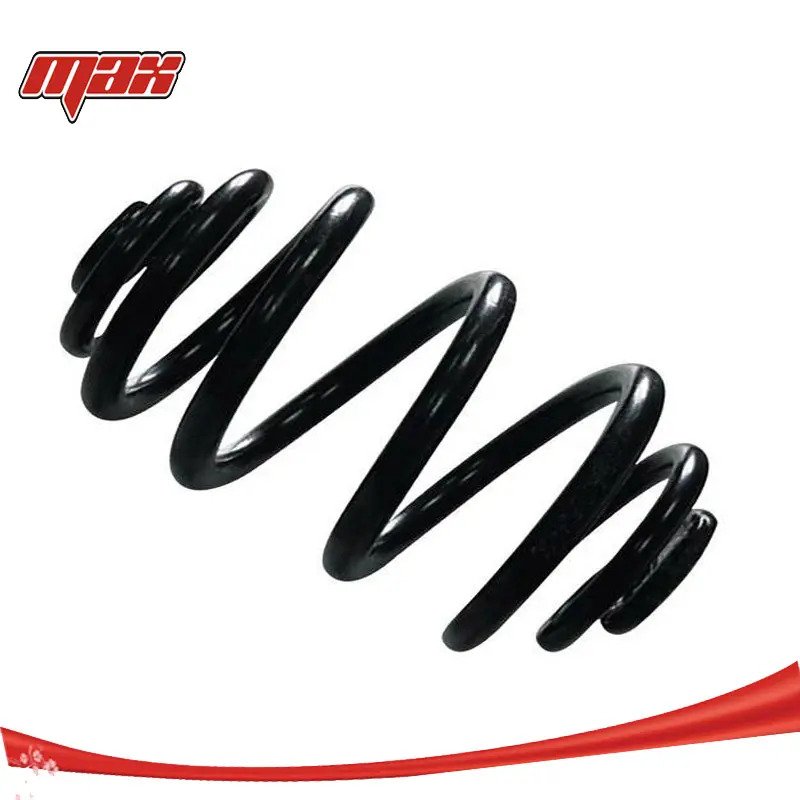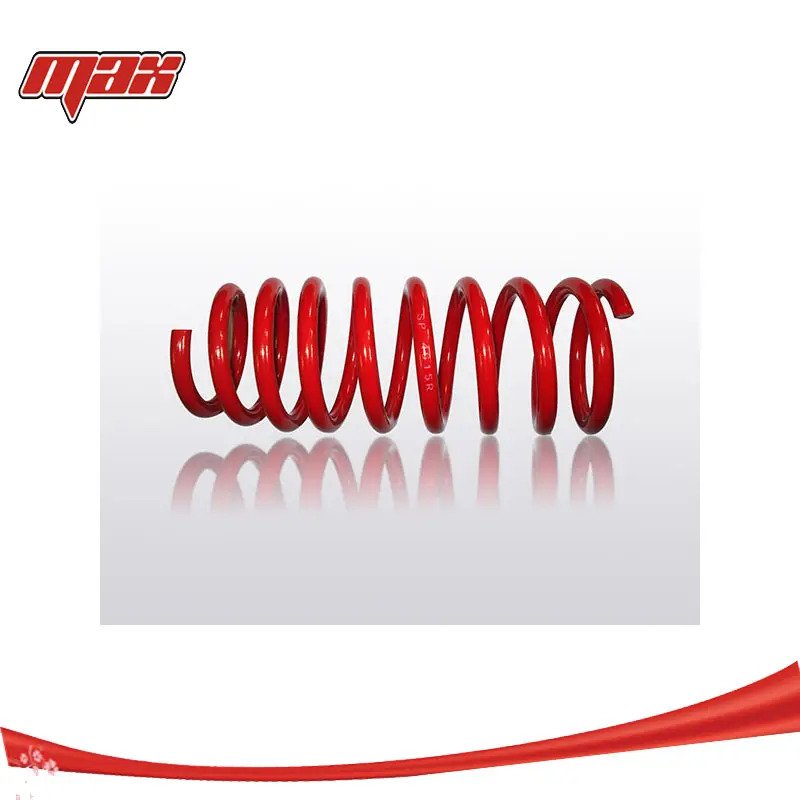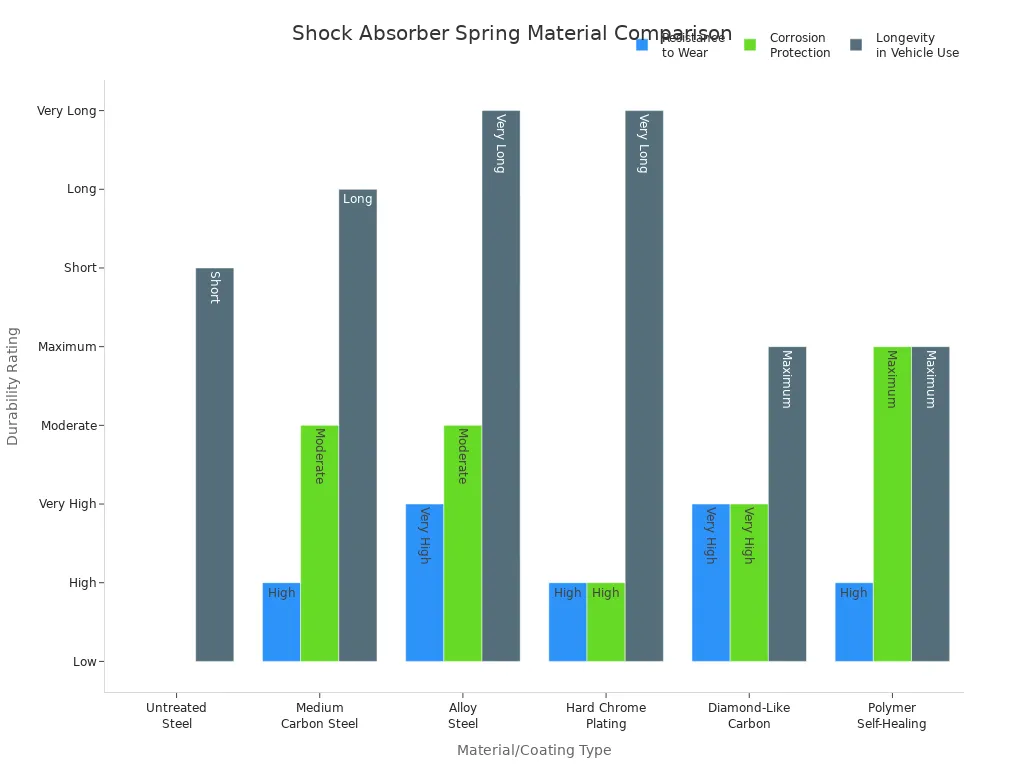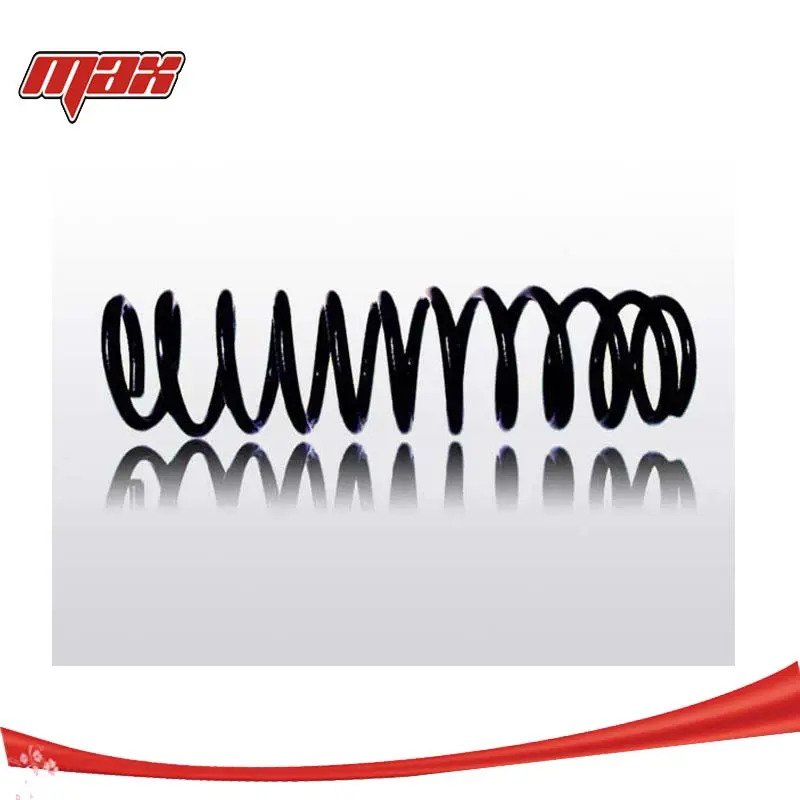
A shock absorber spring helps you enjoy a smoother ride by absorbing bumps and supporting your vehicle’s weight. When the spring works well with your suspension and shock absorber piston rods, you’ll notice improved comfort and control.
- Shock absorber springs boost ride quality, stability, and vehicle dynamics—these are critical for safety.
- Modern vehicles use advanced suspension systems featuring shock absorber springs to meet strict safety standards.
- Manufacturers focus on safety and comfort, often working with shock absorber spring specialists to deliver high-performance parts.
Shock Absorber Spring in the Suspension System

Role in Supporting Vehicle Weight
You depend on the shock absorber spring to hold up your vehicle every time you drive. The spring sits at the heart of the suspension and takes on the job of supporting the entire weight of your car or truck. When you load up your vehicle with passengers or cargo, the spring keeps everything balanced and stable.
- Springs are the main parts that support your vehicle’s weight.
- The suspension system uses springs to absorb bumps and shocks from the road.
- Shock absorbers do not carry weight. They control how the springs move.
When you drive over a bump, the spring compresses and absorbs the energy. This action keeps your ride smooth and prevents the body of your vehicle from bouncing too much. The spring also helps your tires stay in contact with the road, which is important for safety and handling. If your springs wear out, you may notice your vehicle sagging or leaning to one side. Good springs keep your air suspension working well and help your tires last longer.
How Shock Absorber Springs Work with Shock Absorbers
The shock absorber spring and the shock absorber work together as a team. The spring takes in the energy from bumps and rough roads. The shock absorber then controls how fast the spring moves up and down. This teamwork gives you a comfortable ride and better performance.
In a vehicle, shock absorbers reduce the effect of traveling over rough ground, leading to improved ride quality and vehicle handling. While shock absorbers serve the purpose of limiting excessive suspension movement, their intended main purpose is to damp spring oscillations.
When your suspension moves, the spring stores energy and then releases it. Without shock absorbers, the spring would keep bouncing, making your ride uncomfortable and unsafe. The shock absorber slows down this movement by turning the energy into heat. This process keeps your vehicle steady and helps you handle corners and turns with confidence.
Shock absorbers work by taking the kinetic energy (movement) of your suspension and converting it to thermal energy (heat) that is then dissipated into the atmosphere through the mechanism of heat exchange. As the suspension travels up and down, the hydraulic fluid is forced through orifices (tiny holes) inside the piston. Because the orifices only allow a small amount of fluid through the piston, the piston is slowed which in turn slows down spring and suspension movement.
You get better handling and more control when the shock absorber spring and shock absorbers work together. This combination helps your tires grip the road, improves performance, and keeps your ride safe.
Performance Benefits of Shock Absorber Springs
Comfort and Vibration Reduction
You want your ride to feel smooth, even when the road is rough. The shock absorber spring plays a big role in making this happen. When you drive over bumps or potholes, the spring compresses and absorbs the energy. This action keeps vibrations from reaching you and your passengers. The result is a more comfortable and quieter ride.
Coil spring shock absorbers help reduce vibrations and road noise. They act as a barrier, absorbing shocks and dampening the vibrations caused by uneven surfaces. This means you feel fewer bumps, and the cabin stays quieter. Advanced damping in the suspension system manages impacts from potholes and rough roads. The springs compress to absorb energy, smoothing out the ride and improving stability.
Researchers have studied how different materials and designs affect comfort and vibration reduction. Here is a table showing some key findings:
| Study | Findings |
|---|---|
| Li and Wei | Tested rubber materials for heavy-duty vehicle shock absorbers, focusing on tensile and hardness characteristics. |
| Chen and Zhang | Used genetic algorithms to optimize shock absorber structure for better vibration reduction. |
| Wang and Liu | Analyzed how rubber properties affect handling and smoothness using computer models. |
| Zhang and Wang | Developed ways to predict how long rubber shock absorbers will last, helping with durability. |
| Gao and Zhou | Tested rubber dampers in real conditions, giving data for commercial vehicles. |
The vibration reduction system in your vehicle includes tires, body suspension, and seat suspension. Changing the seat suspension can improve shock filtering, making the ride more comfortable for everyone. These changes do not affect handling much, so they offer a cost-effective way to boost comfort.
Handling and Stability Improvements
You need your vehicle to respond quickly and stay stable, especially when turning or stopping. The shock absorber spring helps you achieve improved handling by keeping your tires in contact with the road. This contact gives you better control and more confidence behind the wheel.
When you install high-quality springs, you notice several benefits:
- Improved handling during sharp turns and quick maneuvers.
- Enhanced performance with better traction and steering feedback.
- Reduced body roll, which keeps your vehicle stable when cornering.
- Shorter braking distances, as the suspension keeps the car steady during stops.
Springs and damping work together to manage how your vehicle moves. Damping controls how fast the spring moves up and down. This teamwork leads to improved handling and stability. You feel more in control, and your vehicle reacts better to your steering.
A good suspension system with proper damping also helps with ride performance. It keeps your car balanced and prevents too much weight from shifting during turns or sudden stops. This balance means you get improved handling and a safer driving experience.
Safety and Tire Longevity
Safety matters every time you drive. The shock absorber spring helps keep your tires on the road, which is key for safe driving. By managing weight transfer and vehicle dynamics, the spring improves traction and stability. This action reduces the risk of losing control, especially in emergency situations.
Shock absorbers and springs work together to distribute weight evenly across all tires. This even distribution prevents uneven tire wear. When your tires wear evenly, they last longer and perform better. Under normal driving conditions, shocks move about 1,750 times for every mile you travel. This constant movement shows how important they are for managing your vehicle’s dynamics.
Here are some ways shock absorber springs help your tires last longer:
- They control weight transfer, reducing stress on each tire.
- They keep the suspension balanced, which stops one tire from wearing out faster than the others.
- They help maintain proper alignment, so your tires roll smoothly.
A well-maintained suspension system with effective damping not only keeps you safe but also saves you money by extending the life of your tires.
Types of Shock Absorber Springs
When you look at your vehicle’s suspension, you will find different types of springs. Each type of shock absorber spring has a unique design and purpose. You can see these springs in many vehicles around the world. Here are the most common types:
- Coil springs
- Leaf springs
- Torsion springs
- Air springs
- Hydraulic springs
- Progressive springs
- Linear springs
Let’s explore the main types you will see most often.
Coil Springs
You will find coil springs in most passenger vehicles. These springs look like a spiral or helix. The coil design helps support your car’s weight and absorbs bumps from the road. When you drive over a pothole, the coil compresses and then returns to its shape. This action keeps your ride smooth and steady.
Coil springs offer several advantages. You get better handling and stability. You can adjust coil springs for different driving needs. They also run quieter than other types. Many drivers like coil springs because they allow more suspension movement and a wider tuning range. However, coil springs can cost more than traditional springs. They may not last as long in heavy-duty use.
Here is a table that shows the pros and cons of coil springs:
| Advantages of Coil Springs | Disadvantages of Coil Springs |
|---|---|
| Better handling and stability | More expensive than traditional springs |
| More adjustable and can be fine-tuned | Less durable and may need to be replaced more often |
| Generally quieter | May not be suitable for heavy-duty applications |
| More range of suspension movement | Cost can be high for retro-fits |
| Allows wider tuning envelope | Not preferred for very heavy vehicles |
You will see coil springs in cars, SUVs, and some light trucks. If you want a balance of comfort and performance, coil springs are a great choice.
Leaf Springs
Leaf springs have a long, flat shape made from layers of metal strips. You will often see leaf springs in heavy-duty trucks, buses, and off-road vehicles. These springs help carry heavy loads and keep the vehicle stable.
Here are some vehicles that use leaf springs:
- Commercial trucks
- Buses
- Off-road and utility vehicles
- Trailers
- Railway freight cars
Leaf springs spread the weight across the axle. This design helps your vehicle handle rough roads and heavy cargo. Leaf springs cost less than coil springs and last longer in tough conditions. You may notice a rougher ride with leaf springs, but they give you the strength you need for big jobs.
Air Springs
Air springs use air pressure to support your vehicle. You will find air springs in luxury cars, buses, and some heavy-duty trucks. These springs let you adjust the ride height and stiffness. You can make your ride softer or firmer with air springs.
Here is a table comparing air springs, leaf springs, and coil springs:
| Spring Type | Performance Characteristics | Application Use Case |
|---|---|---|
| Air Springs | Adjustable resistance, superior ride comfort | Best for high-quality ride demands |
| Leaf Springs | Robust, cost-effective, rougher ride | Ideal for heavy-duty trucks and vans |
| Coil Springs | Balance of comfort and durability, less effective in heavy-duty | Suitable for long-lasting performance at a reasonable cost |
Air springs give you a smooth ride and let you change the suspension for different loads. You can raise your vehicle for rough roads or lower it for better handling. Air springs work well if you want comfort and flexibility.
Lowering Springs
When you want to change the look and feel of your car, lowering springs give you a popular option. Lowering springs help you drop your car closer to the ground. You see many drivers choose lowering springs for a sportier appearance and better handling. Lowering springs work by replacing your original springs with shorter, stiffer ones. This change lowers your car’s center of gravity.
You notice several benefits when you install lowering springs.
- Lowering springs improve handling by lowering your vehicle’s center of gravity.
- You experience less body roll when you take corners.
- All four tires grip the road better, so you feel more connected to the pavement.
- Well-designed lowering springs can keep your ride comfortable, similar to standard suspension.
- Sportier lowering springs may give you a firmer ride, especially over small bumps.
Lowering springs and shocks work together to give you the best results. When you pair lowering springs with performance shocks, you get a suspension system that responds quickly and keeps your car stable. Performance shocks help control the movement of lowering springs, so your ride stays smooth and safe. Many drivers ask, “should i get lowering springs?” If you want better handling and a sportier look, lowering springs and struts make a great choice.
You need to choose the best shocks for lowering springs to get the most out of your upgrade. Performance shocks designed for lowering springs help you avoid problems like bottoming out or uneven tire wear. Lowering springs and struts also help you keep your suspension balanced. When you use the best shocks for lowering springs, you protect your car and enjoy a better ride.
Performance shocks work well with lowering springs because they handle the extra demands of a lower suspension. You get better control, more comfort, and a safer driving experience. Lowering springs and shocks give you a complete upgrade that changes how your car feels on the road.
Tip: Always check if your lowering springs match your shocks and struts. This step helps you avoid damage and keeps your ride safe.
You see lowering springs in many sports cars and custom vehicles. Lowering springs give you a bold look and sharper handling. When you want to stand out and enjoy a more exciting drive, lowering springs offer a smart solution.
Key Factors Affecting Suspension Performance
Spring Rate and Stiffness
Spring rate tells you how much force is needed to compress a spring by a certain amount. This factor shapes how your suspension feels and responds. If you choose a higher spring rate, you get a stiffer spring. Stiffer springs give your vehicle more stability and sharper handling, especially when you drive fast or take corners. However, you may notice a rougher ride on bumpy roads. Softer springs absorb more bumps and make your ride smoother, but they can allow more body movement, which may reduce stability during quick turns.
- Stiffer springs reduce body roll and improve handling for performance driving.
- Softer springs increase comfort but can lead to more body movement during cornering.
- Spring rate affects ride comfort, handling, load capacity, and body roll.
- Engineers balance spring rate to get both good handling and a comfortable ride.
- Stiffer springs work best on smooth roads, while softer springs help tires grip better on uneven surfaces.
You need to think about your driving style and the roads you travel when choosing the right spring rate for your suspension.
Materials and Durability
The material of your shock absorber spring plays a big role in how long it lasts and how well it performs. Most springs use steel or alloy steel. These materials offer strength and resist wear. Some springs have special coatings to protect them from rust and damage. The table below shows how different materials and coatings compare:
| Material/Coating Type | Resistance to Wear | Corrosion Protection | Longevity in Vehicle Use |
|---|---|---|---|
| Untreated Steel | Low | Low | Short |
| Medium Carbon Steel (C45) | High | Moderate | Long |
| Alloy Steel (42CrMo4) | Very High | Moderate | Very Long |
| Hard Chrome Plating | High | High | Very Long |
| Diamond-Like Carbon Coating | Very High | Very High | Maximum |
| Polymer Self-Healing Coating | High | Maximum | Maximum |

Steel springs give you good shock absorption and last a long time. Alloy steel springs offer even better fatigue resistance and can be lighter. Coatings like hard chrome or diamond-like carbon add extra protection, boosting durability and keeping your suspension working well for years.
Compatibility and Fitment
Choosing the right spring for your vehicle is important. If you pick the wrong spring, your car might sit too high or too low. This can cause problems with alignment and performance. Here are some key points to remember:
- The wrong spring can lift your vehicle more than you want, leading to reliability issues.
- Over-springing can make it hard to align your wheels, which may cost more to fix.
- The right spring helps your vehicle keep proper alignment without extra changes.
When you look at lowering springs, pay attention to the spring rate, drop level, and the brand’s reputation. Using stock shocks with lowering springs can cause performance problems. Aftermarket shocks designed for lowering springs work better and improve ride quality. Always match your springs and shocks for the best damping control and suspension performance.
Choosing and Replacing Shock Absorber Springs

Signs You Need New Springs
You want your vehicle to deliver a safe and comfortable driving experience. Knowing when to replace your shock absorber springs helps you avoid problems on the road. Watch for these common signs:
- Your vehicle sags or tilts to one side, especially when loaded.
- You hear unusual noises near the wheels.
- Tires show uneven wear patterns.
- The ride feels rough, even on smooth roads.
- The vehicle sways or leans more than usual during turns.
- You notice oily shocks or struts.
- The car feels unstable at high speeds.
- The front dips down sharply when you brake.
- Steering becomes difficult or less responsive.
Inspect your suspension system, including shock absorbers and springs, at least once a year or every 12,000 miles. If you drive in harsh conditions, check every 6,000 to 8,000 miles. Always look for damage after hitting potholes or curbs. Regular checks keep your driving experience safe and enjoyable.
What to Consider When Upgrading
When you plan a modification for your suspension, you want to improve your driving experience and achieve better handling. Consider these important factors before you upgrade:
| Factor | Description |
|---|---|
| Combination of springs and shocks | Matching both parts ensures you get the best driving experience and handling. |
| Adjustable shocks | These let you tune ride height and damping for different driving needs. |
| Build Quality | High-quality materials last longer and perform better, making your modification worthwhile. |
| Spring Rates | The right balance between soft and stiff springs gives you comfort and better handling. |
Think about how you use your vehicle. If you want better handling for daily driving or sportier performance, choose springs and shocks that match your goals. A good modification can transform your driving experience.
Professional Installation vs. DIY
You may wonder if you should install new springs yourself or ask a professional. If you have experience with car repairs and the right tools, a DIY modification can save money. However, suspension work affects your driving experience and safety. Professional installers have the skills to ensure everything fits and works as designed.
Tip: If you want the best results and peace of mind, choose a professional for your suspension modification. This choice helps you get better handling and a safer driving experience.
No matter which option you pick, always follow the manufacturer’s instructions. Proper installation gives you the full benefits of your new springs and shock absorbers, making every driving experience smoother and more enjoyable.
You improve ride quality and driving comfort when you maintain shock absorber springs. Follow these expert tips for the best results:
- Check tire pressure monthly and schedule wheel alignments every six months.
- Replace worn parts quickly to protect your suspension.
- Listen for warning signs like clunking noises or rough rides.
- Lubricate suspension joints to keep movement smooth.
| Common Mistakes | Description |
|---|---|
| Improper Installation | Install shocks at optimal ride height to avoid damage. |
| Failure to Replace All Parts | Replace all worn components to prevent uneven wear. |
| Neglecting Compatibility | Ensure correct orientation for springs to avoid rubbing and noise. |
Trusted suppliers test shock absorber springs for quality and compatibility. You save money over time by keeping your suspension in good condition. Choose high-quality parts to keep your vehicle safe and performing well.
FAQ
What is the difference between springs and shocks in my car’s suspension?
You use springs to support your vehicle’s weight and absorb bumps. Shocks control the movement of springs and stop your car from bouncing. Both work together to give you a smooth and safe ride.
How do I know if I need new shocks or springs?
You may notice your car bouncing too much, sagging, or making noises. Uneven tire wear can also signal problems. If you see these signs, check your shocks and springs. Replacing worn parts keeps your ride safe.
Why is selecting the right coil spring important for my vehicle?
Selecting the right coil spring ensures your car sits at the correct height and handles well. The right springs improve comfort and stability. If you choose the wrong type, you may damage your suspension or affect your driving experience.
Can I upgrade to a lowered suspension with my current shocks and springs?
You need to match your shocks and springs when upgrading to a lowered suspension. Using the wrong parts can cause poor handling or damage. Always check if your shocks support a lowered suspension before making changes.
What should I consider when selecting the right coil spring for performance driving?
When selecting the right coil spring, look at spring rate, material, and fit. The correct springs work with your shocks to improve handling. Performance driving needs springs that balance comfort and control for the best results.
